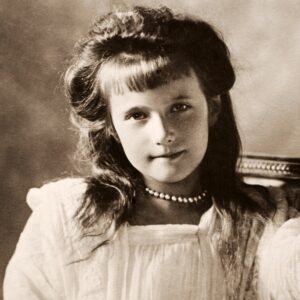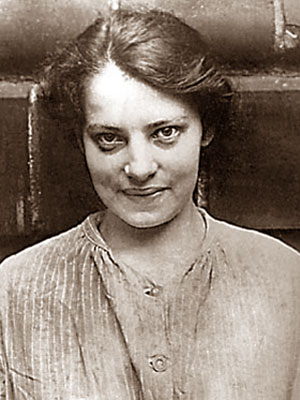
It was a cold and treacherous day in February of 1920, when a woman decided to commit suicide by jumping off a bridge into the Landwehr Canal in Germany. With calm ripples, the canal brought comfort and relief to many. The woman, feeling at her all-time low, believed that dying in peace would take her pain away; however, she was later rescued by police officers, who documented she was 5’2 and weighed approximately 110 pounds; but when they tried to talk to her, she kept quiet. She was taken to a hospital, registered as “Fräulein Unbekannt” (Miss Unknown). They found scars from past physical violence, among them several lacerations and fractures in her upper and lower jawbones. After recovering, she was then taken to the Dalldorf Mental Asylum.1 During her time there, she was very reserved and quiet; but she continued to keep her identity a secret, only being known as Miss Unknown.
During her time in the asylum, a woman, Clara Peuthert, was convinced that Miss Unknown was one of the Tsar princesses.2 On October 23, 1921, a detailed article about the Romanovs was published in the German weekly Berliner Illustrirte Zeitung, which included images of the Imperial family and a suggestion that one of the Tsar’s daughters had escaped from her captors. Miss Unknown used this to her advantage, as she began dropping hints here and there that she was Anastasia Romanov by showing photos to the staff and asking if she showed resemblance to Anastasia, which they acknowledged.3 Once Peuther was released, she began to spread this rumor by telling various Russian officials and others, leading many visitors to visit Dalldof’s asylum to see if she was actually the Tsar Romanov princess.4 Years earlier, on July 17, 1918, early in the morning, members of the Romanov family and their servants were carried to the cellar of the Ipatiev House, where they were detained and put to death.5 However, Miss Unknown allegedly claimed that on the night of the execution, she lost consciousness, and a soldier had saved her and taken her to Romania. She stated the couple married in 1919, and had a child; and that soldier’s name was Alexander Tschaikovsky. She clarified that she only departed for Berlin after Tschaikovsky was killed in a battle.6
In May of 1922, Miss Unknown left the asylum after only living there for a year and a half. She was taken in by one of her gullible believers, Baron Arthur von Kleist and his wife Marie von Kleist. Several people continued to visit Miss Unknown, feeding into her Anastasia illusion. As a consequence, she touched people’s hearts, making them sympathetic to her and determined to restore her memories by providing her with countless pieces of information about Anastasia and the Romanov family.7

Anastasia Romanov was born in 1901 in Petrodvorets, Russia; her parents were none other than Tsar Nicholas II and Tsarina Alexandra. Although she was the youngest daughter of the Imperial Romanov rulers of Russia, last of five siblings, she lived in a society where only men could inherit the crown.8 In the royal eye, Anastasia was seen as a disappointment compared to her other sisters, until Nicholas and Alexandra finally had a son, Alexi, who was later found to have suffered from hemophilia.9 Anastasia had golden hair, piercing blue eyes, and mischievous humor. Her character displayed her strong will and boundless vitality. She also knew how to make people smile and laugh by brightening up a room. Growing up in a household where discipline was of the utmost importance, she was forced to study four languages, music, drawing, and needlework. Much of Anastasia’s schooling didn’t make her happy; however, she did enjoy playing jokes on teachers and nurses, and she enjoyed impersonating ostentatious guests. She frequently devoted hours to hand-coloring pictures, adding illustrations to messages to emphasize certain details.10 Anastasia was only fifteen years old in 1917, when the Romanov family was taken to Tobolsk, Siberia as captives during the Russian Civil War.
In the 1920s, Miss Unknown changed her name to Anna Anderson, a shortened version of Anastasia. Miss Unknown and Anastasia resembled each other in terms of appearance. They shared the traits of being short in height and in having a big toe deformity, hallux valgus. Both had eyes that were a similar shade of blue-gray, just as those of Nicholas, Anastasia’s father. Anderson also had scars that matched those of Anastasia, who had survived the tragedy. Many people were convinced by the fact that Anderson could do needlework, as it was seen that only a girl from a wealthy and aristocratic background would have had the time and resources to learn such a time-consuming skill. Anderson also had a talent for absorbing information and making it her own; however, she was also careful in what she exposed herself to: she strayed away from dangerous situations. Many times, when she was put into a sticky situation, she blamed it on her ill health, or on the traumatic memory lapse she endured. For instance, when requested to speak Russian, she declined, stating that it was too painful; when guests questioned her in Russian, she responded in German.11
Now, the royal family’s stance was very opinionated on whether Anna Anderson was the actual Tsar princess, Anastasia. At the first visit, many royals and advocates of the crown were convinced that Anderson was Anastasia. Princess Xenia Georgievna stated, “At all times, she was herself and never gave the impression of acting a role. She never, no matter what the pressure, ever made an error that would have shaken my growing conviction and final complete embrace in her identity.” There were some royals and advocates of the crown that were initially convinced; however, they often later changed their minds and presumptions of Anderson’s claim. Grand Duchess Olga Alexandrovna (Anastasia’s aunt), Gillard (family tutor), and Tatiana Botkin (the Imperial family’s physician), all knew Anastasia fairly well, which made them change their minds after the first visit, as Anderson started showing signs of abnormal behavior.12
Many Tsar loyalists still supported Anna Anderson through thick and thin. A man named Felix Schanzkowska came forward claiming to be her brother; however, he eventually withdrew his claim, fearing legal action if the truth came out, and he cut off his relations with Anderson. The mystery continued on until Anderson challenged her right to a share of the Romanov family assets in a lawsuit she filed in a German court in 1938. After decades of delay, finally in 1970, the courts did not reach a verdict, rendering without a decision as Anderson failed to prove her claim.13
After much delay, Anderson became frustrated with the legal proceedings and made the decision to start her life over in the United States, where she subsequently married wealthy John Eacott Manahan in 1968. Manahan was known for having a sort of bizarre persona, which can explain why he was so infatuated with Anderson. He wanted to help Anderson, so he spent the majority of his life trying to prove she was Anastasia. Anderson died of pneumonia on February 12, 1984, in Charlottesville, Virginia; nevertheless, Anastasia, daughter of Nicholas II, was recorded on her death certificate.14
In 1991, scientists made a massive discovery of the remains of nine bodies in a forest near Yekaterinburg, Russia. Dr. Peter Gill, a former member of the Forensic Science Service (FSS), and Dr. Pavel Ivanov, a Russian geneticist, tested the remains using DNA. The corpses’ sex was confirmed by nuclear DNA testing using five STR markers, and the link between Tsar Nicholas, Tsarina Alexandra, and three of their daughters’ (Maria, Olga, and Tatianna) remains were retrieved from the burial.15 This would not have been possible if not for their being able to use some of Prince Philip’s DNA samples to identify the bodies. Prince Philip, Duke of Edinburgh, was the closest relative to the Tsar family, through Queen Victoria.16 Following a thorough investigation, it was discovered that the majority of the bodies had been dumped in a hole and sulfuric acid had been added to prevent identification; however, two bodies, Alexei and Anastasia’s, were still missing.17

Even after her passing, Anderson’s admirers and haters agreed that she had died carrying the truth of who she actually was to her grave, but in 1994, the mystery came to a close when a DNA test was performed on Anderson. A hospital pathology lab had saved some of Anderson’s hair and intestinal tissue, which was used to determine if she was the real Tsar princess Anastasia. Anderson’s DNA was compared to that of Prince Philip and found it was not a match, meaning that she was not the real Tsar princess, Anastasia Romanov. Bewildered by this announcement, many Russian Tsarist believers started to question if she is still alive, and if so, then where could she be? In the summer of 2007, a group of amateur archaeologists came upon a burial site around 70 meters from the larger cemetery, and they meticulously removed 44 bone pieces and teeth from the second grave.18 The remains from the 2007 discovery were subjected to forensic DNA analysis utilizing Y-STR, autosomal STR, and mitochondrial DNA (mtDNA), as well as analysis with further DNA testing from the burial discovered in 1991.19 After identifying both Alexi and Anastasia, they were finally laid to rest in the St. Petersburg Cathedral in Russia, along with the rest of the Romanov family. If the real Anastasia Romanov was found, then who was Anna Anderson? Well, her DNA was also compared with a former factory worker, Franziska Schanzkowska, related to Felix Schanzkowska, which was also a long-standing rumor. Scientists found out with 98.5 percent certainty that the former Anna Anderson and Franziska Schanzkowska were the same person.20

As for Franziska Schanzkowska, she lived in Kashubian village, which boarded West Prussia when she was a young. She grew up being her father’s favorite, which meant she got away with a lot of things she did not have to do, like farm chores. When she turned eighteen, Schanzkowska moved to Berlin where she landed a job at an AEG turbine factory, assembling ammunition. She fell in love and got engaged to a soldier; however, he died after he was sent to combat, which created a downward spiral for her. Schanzkowska was declared insane and sent to a German ward until 1917, where she was then taken to an internment camp for Russian POWs, where she learned Russian. In February 1920, Schanzkowska decided to commit suicide by jumping into the Landwehr Canal, where officers found her unresponsive.21
- “Anna Anderson,” Encyclopedia of World Biography Online (Detroit, MI: Gale, 2020). ↵
- Frances Welch, A Romanov Fantasy : Life at the Court of Anna Anderson (New York : W.W. Norton & Co., 2007), 101-105. ↵
- “Anna Anderson,” in Encyclopedia of World Biography Online (Detroit, MI: Gale, 2020). ↵
- Frances Welch, A Romanov Fantasy : Life at the Court of Anna Anderson (New York : W.W. Norton & Co., 2007), 101-105. ↵
- Susuan Colman, “Identification of Anastasia Romanov’s Remains,” Salem Press Encyclopedia of Science, 2020. ↵
- “Anna Anderson,” in Encyclopedia of World Biography Online (Detroit, MI: Gale, 2020). ↵
- “Anna Anderson,” in Encyclopedia of World Biography Online (Detroit, MI: Gale, 2020). ↵
- Rebecca Zukauskas, “Grand Duchess Anastasia Nikolaevna of Russia.,” in Salem Press Biographical Encyclopedia (Salem Press, September 1, 2022), Research Starters. ↵
- Candace Fleming, The Family Romanov: Murder, Rebellion & the Fall of Imperial Russia, First edition (New York: Schwartz & Wade Books, 2014), 45-56. ↵
- “Anastasia Nicholaievna Romanov,” in Encyclopedia of World Biography, 2nd ed., vol. 18 (Detroit, MI: Gale, 2004), 354–57. ↵
- “Anna Anderson,” in Encyclopedia of World Biography Online (Detroit, MI: Gale, 2020). ↵
- “Anna Anderson,” in Encyclopedia of World Biography Online (Detroit, MI: Gale, 2020). ↵
- “Anna Anderson,” in Encyclopedia of World Biography Online (Detroit, MI: Gale, 2020). ↵
- “Anna Anderson,” in Encyclopedia of World Biography Online (Detroit, MI: Gale, 2020). ↵
- Michael D Coble, et al., “Mystery Solved: The Identification of the Two Missing Romanov Children Using DNA Analysis,” PLoS ONE 4, no. 3 (January 1, 2009): e4838–e4838. ↵
- Susuan Colman, “Identification of Anastasia Romanov’s Remains.,” Salem Press Encyclopedia of Science,2020,Research Starters. ↵
- Michael D. Coble, et al., “Mystery Solved: The Identification of the Two Missing Romanov Children Using DNA Analysis,” PLoS ONE 4, no. 3 (January 1, 2009): e4838–e4838. ↵
- Michael D Coble, et al., “Mystery Solved: The Identification of the Two Missing Romanov Children Using DNA Analysis,” PLoS ONE 4, no. 3 (January 1, 2009): e4838–e4838. ↵
- Susuan Colman, “Identification of Anastasia Romanov’s Remains.,” Salem Press Encyclopedia of Science,2020,Research Starters. ↵
- “Anna Anderson,” in Encyclopedia of World Biography Online (Detroit, MI: Gale, 2020). ↵
- “Anna Anderson,” in Encyclopedia of World Biography Online (Detroit, MI: Gale, 2020). ↵




24 comments
Sudura Zakir
This is the tale of a very sophisticated impersonation that wasn’t initiated by Schanzkowska but by someone else. She simply utilized it to her advantage throughout her life, reaping numerous rewards but eventually suffering some drawbacks as well. Many individuals, including some members of the Tsar’s family, were duped into thinking Anna Anderson was Anastasia. However, DNA proof ultimately established the truth while also raising the issue of Anastasia’s ultimate fate. Excellent historical mystery narrative.
Joseph Frausto
Wow!Very informative article which masterfully blends cold scientific fact and a gripping historical narrative. The departure from the original story to offer a background on the real Anastasia, the DNA testing, and the recovery of the bodies kept me on the edge of my seat and wanting to read more. I loved the section at the end describing the dna results for
Anderson. Great Job!!
Fernando Milian
What a remarkable story, and what an excellent way to tell it. With this article, you not only demonstrate your writing skills but also a unique ability to put many pieces of a story together in such an exciting way. I think the first time I heard about Princess Anastasia was through Disney’s movies. I never imagined that story could be based on actual facts. Your award is well-deserved for this fabulous article. Congrats!
Christian Lopez
There are countless stories that go unremembered by mainstream history, this is one of them. Tales like this paint horrible times like this in different lights. During this time in history, there were so most extraordinary events that happened that need to be brought to light like this.
Carina Martinez
Wow, this was an amazing article! I learned a lot from this article, things I never knew before. I have seen the animated movie of this story, and I was very interested to read the actual story behind it! Congratulations on your award.
Carlos Alonzo
Congratulations on your award! Significant people in history are dying tragically, however what I find the most interesting from your article is the theme that Russian Princess Anastasia Romanov was strong for the situations she encountered. Thankfully, the investigations led to the identification of the bodies. I wish that the DNA tests would have been sooner, but DNA analysis was not the primary sought after piece of evidence.
Jared Sherer
This is a story of a very intricate impersonation, one that did not start with Schanzkowska, but with another person. She just used it to her advantage during her life, and received many benefits, but ultimately some disadvantages as well. Anna Anderson was able to con many people, and even some of the Tsar’s family, into believing she was Anastasia. However, DNA evidence finally proved the truth, but it also left open the question of the final story of Anastasia. Very good story of a historical mystery
D'vaughn Duran
Congratulations on being nominative! This article is very interesting regarding history. I didn’t know anything about this topic of “Miss Unknown” was maybe Tsar Princesses. Some information about Miss Unknown later changed her name, “Anna Anderson”. Also, the marks match Anastasia Tsar Princesses. This article was very interesting in a reader stand point and kept the reading on their feet, which I liked!
Peter Alva
I enjoyed reading this article because it’s something different about and the layout of her story is amazing. It’s amazing that she was a part of something so big and she was essentially in hiding for a really long time. Its amazing that we are not able to read and feel her story.
Kristen Leary
Congratulations on the article nomination! The story of Anastasia and the Romanov family has always interested me, so I really enjoyed reading your article. Your writing told the story very well, and you have great use of description. It impressed me how well organized everything was. Well done on a great article!